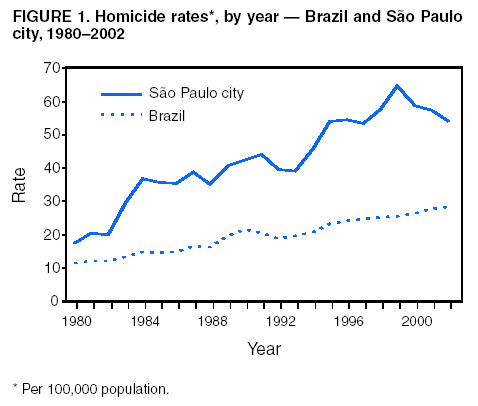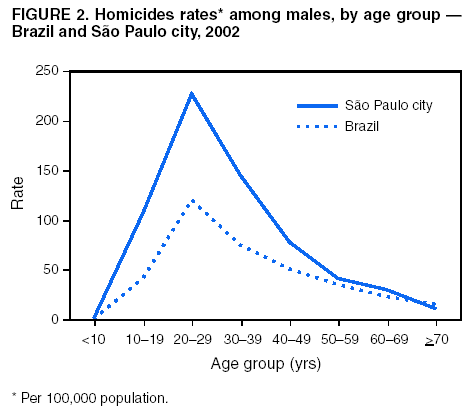 |
|
|
|
|
|
|
| ||||||||||
|
|
|
|
|
|
|
||||
| ||||||||||
|
|
|
|
|
Persons using assistive technology might not be able to fully access information in this file. For assistance, please send e-mail to: mmwrq@cdc.gov. Type 508 Accommodation and the title of the report in the subject line of e-mail. Homicide Trends and Characteristics --- Brazil, 1980--2002Brazil is the largest and most populous country in South America (2002 population: approximately 175 million) (Brazilian Geography and Statistics Institute [BGSI], unpublished data, 2004). Although life expectancy in Brazil has increased and rates of infant mortality have decreased as a result of reductions in infectious disease mortality, homicide and other forms of injury-related mortality have increased as a proportion of overall mortality (1,2). Homicide is now the leading cause of death for persons aged 15--44 years. To describe trends and characteristics of homicides countrywide and in São Paulo city (2000 population: approximately 10.4 million) (BGSI, unpublished data, 2004), the State Health Department of São Paulo (SHDSP) analyzed vital statistics and census data for 1980--2002. This report summarizes the results of that analysis, which indicated that the homicide rate in Brazil more than doubled during this period (Figure 1). Since 2001, Brazilian authorities have implemented several initiatives to reduce the number of homicides, including a law that controls gun ownership and prohibits anyone other than police and members of the armed forces from carrying guns. However, homicides among adolescents and young adults remain a substantial public health problem in Brazil, and additional prevention strategies that target young persons are needed. Data were obtained from the Mortality Information System operated by Brazil's Ministry of Health. This database includes information from death certificates for all states in Brazil. Additional data for São Paulo city were obtained from the Program for Quality Improvement of Mortality Information. Homicide was defined as a death resulting from an injury that was inflicted purposefully by another (including legal intervention) for which the underlying cause listed on the death certificate corresponds to codes E960--E978 and E970--E978 of the International Classification of Diseases, Ninth Revision for 1980--1996, and codes X85--Y09 and Y35 of the Tenth Revision for 1997--2002. Population data for Brazil and São Paulo city were obtained from BGSI. Crude, age-, and sex-specific rates were calculated per 100,000 population. To examine the association between socioeconomic status and homicide rates in São Paulo city, SHDSP obtained data on the monthly average income of heads of households in all 96 city districts from the 2000 Brazil Population Census. Pearson correlation analysis was used to test this association. During 1980--2002, the homicide rate in Brazil more than doubled, from 11.4 per 100,000 population to 28.4. In São Paulo city, the rate more than tripled, from 17.5 in 1980 to 53.9 in 2002 (Figure 1). In 2002, a total of 49,570 homicides were documented in Brazil. Firearms and sharp objects were the weapons used in 34,085 (68.8%) and 6,728 (13.6%) of all incidents, respectively. In 2002, the homicide rate was 53.1 among males and 4.3 among females, and adolescent (aged 15--19 years) and young adult (aged 20--29 years) males accounted for 52.2% of homicide victims. By age group, the homicide rate was highest among young adult males (121.0). In 2002, a total of 5,719 homicides occurred in São Paulo city. Firearms and sharp objects were used in 62.0% and 4.7% of all incidents, respectively. The homicide rate for males (105.1 per 100,000 population) was nearly 15 times that for females (7.2). Adolescent and young adult males accounted for the largest proportion (59.8%) of homicide victims, and age-specific homicide rates were highest among males aged 20--29 years (227.4) (Figure 2). The risk for homicide varied substantially by city district. In 2002, crude homicide rates ranged from 1.2 in the Jardim Paulista District to 115.8 in the Guaianazes District. In some districts, homicide rates for males aged 15--29 years were >400. A negative correlation was observed between the average monthly income of heads of households and homicide rates in these districts (Pearson correlation coefficient = -0.58; p<0.05). Reported by: VP Gawryszewski, PhD, Research Institutes Coordination, State Health Dept of São Paulo, Brazil. JA Mercy, PhD, Div of Violence Prevention, National Center for Injury Prevention and Control, CDC. Editorial Note:The findings in this report indicate that homicide rates in Brazil and São Paulo city increased markedly during 1980--2002. Other countries in the Americas have experienced similar increases in homicide rates during this period (3). In 2002, Brazil had one of the world's highest homicide rates, nearly four times higher than that for the United States (4). In 2000, Brazil accounted for an estimated 28% of all the homicides that occurred in the Americas, a region that has the highest homicide rate (4). Factors that might have contributed to increased violence include increasing urbanization, expansion of illegal drug and firearms trafficking, a lengthy economic crisis, increased unemployment, and widening income inequality (5--7). The strong negative correlation between monthly average income and homicide rates in São Paulo city described in this report is consistent with homicide research in other urban areas worldwide (8). Further research is needed to better understand the association between violence and poverty so appropriate interventions can be developed. This association might be attributed to income inequality and disparities in job and education prospects. Brazil has adopted measures to reduce the number of homicides. In 2001, the Brazil Ministry of Health issued a national policy to reduce injury-related morbidity and mortality and, in 2002, Brazil issued guidelines for the reporting of child maltreatment by health professionals. In December 2003, the Brazilian Congress passed a law that controls gun ownership and prohibits anyone other than police and members of the armed forces from carrying guns. The law also established tougher penalties for international firearms trafficking. The country also plans to implement an emergency department--based registry for injuries. In 2002, the government of São Paulo state passed legislation to establish an injury surveillance system. Improved surveillance data can help guide program and policy design and monitor progress toward reducing levels of violence (4). Several violence-prevention initiatives have been developed in Brazil. In Rio de Janeiro, Viva Rio, a nongovernment organization, directs projects for 1) promoting awareness about the risks of using or carrying firearms, 2) reducing firearm injuries, 3) promoting peace, and 4) providing vocational training for youths who live in impoverished communities. In São Paulo state, a coalition of private sector investor groups, state banking organizations, advertising and media companies, and research centers established the São Paulo Institute Against Violence to support projects for violence prevention. In addition, the local government of São Paulo city implemented the Renda Minima Program, which provides financial support to low-income families, and the Bolsa Trabalho Program, which promotes youth employment; both programs might help reduce the homicide rate. The impact of these efforts should be evaluated to guide development of interventions in other communities. The findings in this report are subject to at least two limitations. First, data from death certificates might underestimate the proportion of firearm-related homicides. Studies based on medical examiners' records have documented that, in large Brazilian cities like Recife, >90% of homicides involve firearms, whereas death certificates indicate that <70% of deaths were firearm related (9). Second, information is lacking about perpetrator characteristics or circumstances of these deaths (e.g., place of occurrence, relationship between victim and offender, and the use of alcohol and other substances). A homicide surveillance system is being planned for São Paulo city that will link information from death certificates with medical examiner and police records to guide public policies. Homicides among adolescents and young adults constitute a substantial public health problem in Brazil, and additional prevention strategies that target young persons are needed. These strategies should include partnerships among the government, universities, the private sector, nongovernment organizations, and communities. References
Figure 1  Return to top. Figure 2  Return to top.
Disclaimer All MMWR HTML versions of articles are electronic conversions from ASCII text into HTML. This conversion may have resulted in character translation or format errors in the HTML version. Users should not rely on this HTML document, but are referred to the electronic PDF version and/or the original MMWR paper copy for the official text, figures, and tables. An original paper copy of this issue can be obtained from the Superintendent of Documents, U.S. Government Printing Office (GPO), Washington, DC 20402-9371; telephone: (202) 512-1800. Contact GPO for current prices. **Questions or messages regarding errors in formatting should be addressed to mmwrq@cdc.gov.Page converted: 3/4/2004 |
|||||||||
This page last reviewed 3/4/2004
|